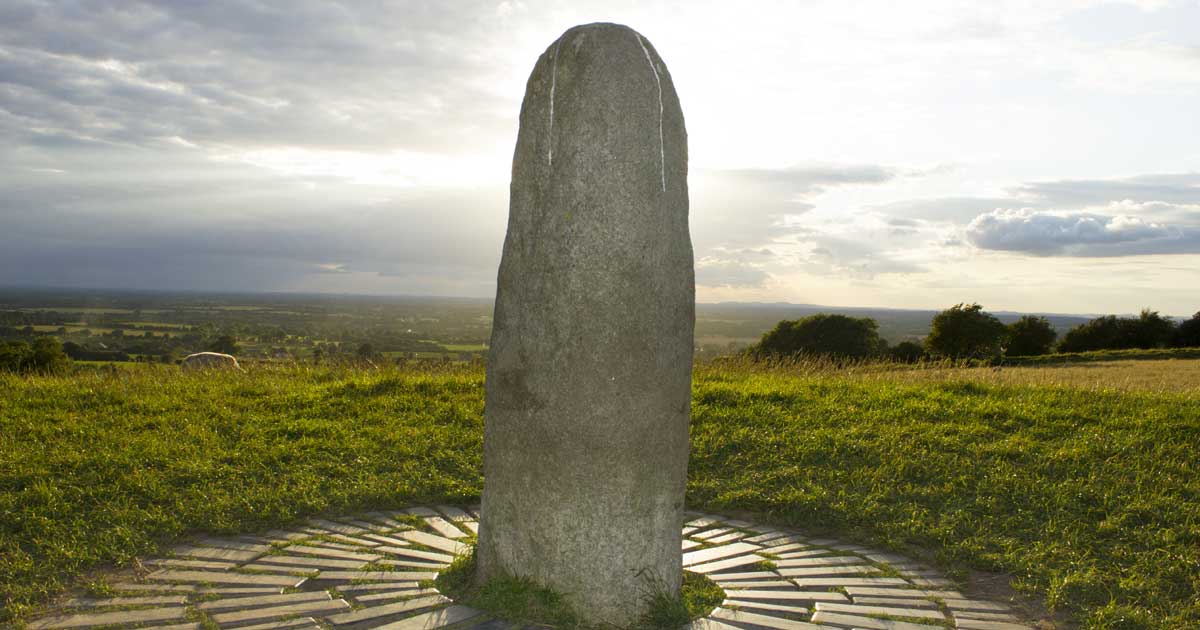Legendary Lia Fáil: A Roaring Rock for the Coronation of Ancient Irish High Kings
Lia Fáil is a carved standing stone on the Hill of Tara. Legends say this Stone of Destiny roared at the touch of a true king, making it the coronation stone for the High Kings of Ireland from the earliest monarchs all the way until 500 AD.
Also known as the Coronation Stone, the Lia Fáil is found at the Inauguration Mound on the famed Hill of Tara in County Meath, Ireland. Locals believe all of the High Kings of Ireland up to Muirchertach mac Ercae in 500 AD were crowned on the stone.

The Stone of Destiny, Lia Fáil, found on the Hill of Tara in Ireland. (Verdasuno/CC BY SA 3.0)
Legendary Origins of the Lia Fáil
According to a collection of writings and poems known as the Lebor Gabála Érenn, the semi-divine race of the Tuatha Dé Danann were responsible for bringing the Lia Fáil to Ireland. They traveled to the Northern Isles to learn many skills and magic in the cities of Falias, Gorias, Murias and Findias. Then they traveled from the Northern Isles to Ireland, bringing a treasure from each of the cities, including the Lia Fáil, the Claíomh Solais or Sword of Victory, the Sleá Bua or Spear of Lugh, and the Coire Dagdae or The Dagda's Cauldron. The Lia Fáil is said to have come from the city of Falias. Many believe that this legend explains how the stone arrived in Ireland.
- Following the Footsteps of the High Kings of Ireland at the Sacred Hill of Tara
- The Hill of Sorcery: Mythology and Archaeology of the Tlachtga Barrow
- Thoth’s Storm: New Evidence for Ancient Egyptians in Ireland?

A plate of The Dagda, representing the legendary members of the Tuatha Dé Danann. (Public Domain)
“Roaring With Joy” for the New King
One traditional tale about the Lia Fáil is that long ago the stone would utter a shout, or would “roar with joy” whenever a king of the true Scottish or Irish race stood or sat on the stone, or placed his feet upon it. Stones that make sounds or speak are a common component in old Irish folk tales. Through the stone’s power the king would be rejuvenated and would enjoy a long reign. Receiving the Lia Fáil’s approval was one of several trials would-be High Kings had to pass. Another trial involved driving his chariot between two more standing stones that were located nearby. Stories say the stones would jump out of his way if the man was meant to be king.
According to the legend, Cúchulainn was angered when the stone did not cry out for his protégé, Lugaid Riab nDerg. In retaliation, Cúchulainn struck the stone with his sword, splitting it. From that day forward, the stone never cried out for anyone again, except for Conn of the Hundred Battles. Although Cúchulainn had split the stone in anger, seemingly destroying the powers that allowed it to cry out, the stone still roared under Conn’s touch, according to the collection of poems and prose narratives known as the Lebor Gabála Érenn.
However, in another writing, Baile in Scáil, Conn only walks over the stone by accident, as it had been buried after being destroyed by Cúchulainn. Regardless of whether Conn tread upon the stone intentionally, or by accident, it is said it roared for him and legend held true as Conn enjoyed a long reign as king.

Cúchulainn, is the central character of the Ulster (Ulaid) cycle in the in medieval Irish mythology and literature. According to tale, he split the Stone of Destiny in anger. Public Domain
The Lia Fáil’s Strong Symbolic Link
The Lia Fáil remains erect on the Hill of Tara to this day, a site which has been in use by people since Neolithic era. It is a menhir, or upright standing stone, and many such prehistoric stones were thought to be magical by later cultures. The ancient history of the stone provides a strong symbolic link between the Celtic people of Scotland and Ireland.

The Hill of Tara is an archaeological complex featuring many ancient monuments, such as the ‘Mound of Hostages’, seen above. In tradition Hill of Tara is known as the seat of the High Kings of Ireland. (Poleary91/CC BY SA 4.0)
The Irish legends surrounding the stone have been retold and reimagined over time, but the stone remains a symbol of the kings who were crowned upon it, and represents the mythical powers which caused the stone to roar with joy when a king stood upon it.
- When Irish Legends and History Combine: The Tomb of the Fairy Queen Maeve
- Could Ireland’s Cairn T Really Be the Tomb of the Prophet Jeremiah?
- Magic Armor Can’t Save the Tragic Heroes: Duty & Doom for Karna, Ferdiad & Achilles
Vandalism and Controversy
Unfortunately, the stone has been vandalized on two occasions. In 2012, it was struck repeatedly with a hammer, leaving eleven areas of damage. In 2014, red and green paint were poured over the stone, covering 50% of the surface. In spite of this damage, the symbolism of the Lia Fáil within Irish culture remains.
But not everyone is convinced that the Lia Fáil seen today is the true Coronation Stone of lore. Some claim the real stone was smuggled into Scotland where it became another famous coronation stone – The Stone of Scone – a rock used to crown Scottish and English monarchs.
Others believe the Lia Fáil you see today is just an imposter because the real one has been hidden away until Ireland is ready to be ruled by another High King.
Top Image: The Lia Fáil on the Hill of Tara. It is also known as the Coronation Stone for the ancient High Kings of Ireland. Source: JohnJDuncan/CC BY SA 4.0
By M R Reese
References
The Coronation Stone - Lia Fail – Bible Mysteries. Available from: http://www.biblemysteries.com/library/liafail.htm
The Lia Fail or Coronation Stone of Tara – Library of Ireland. Available from: http://www.libraryireland.com/Wonders/Lia-Fail-1.php
What is Lia Fáil? – LiaFailPipes. Available from: http://liafailpipes.com/about-the-band




















Comments
Can tourists visit this site? Is it free of charge since it is open to the elements? Whose is the responsability, the National Heritage?
- Moonsong
--------------------------------------------
A dreamer is one who can only find his way by moonlight, and his punishment is that he sees the dawn before the rest of the world ~ Oscar Wilde
One of the more fascinating tales, is that the the stone that is there now is now the real Lia Fáil.
The story goes that members of Scottish/Irish clans in Scotland borrowed the stone to crown some Scottish kings. It was never returned to Ireland and remained in Scotland for sometime, it was kept in a town called scone. Years later during some English/Scottish conflict, the stone was stolen by the English as has been used up to the present day to crown every member of the British monarchy. The stone currently is the base of the coronation chair in Westminster abbey.
As you can imagine a stone the size of the Lia fáil at Tara would be hard to stand up during coronation. An actual coronation stone would have to be much smaller, so there is some truth to the tale in my opinion.
Close to the top of my 'must-vist' list - unfortunately didn't have time to visit last time I was in Ireland.
Thanks for the article!
Sculptures, carvings & artwork inspired by a love of history & nature: www.justbod.co.uk
Maybe it's nothing but here the Dagda
http://i448.photobucket.com/albums/qq206/Lady_of_Gaerdon/Imbolc%20Diary/...
is similiar to Aker
http://www.landofpyramids.org/images/twin-lions.jpg